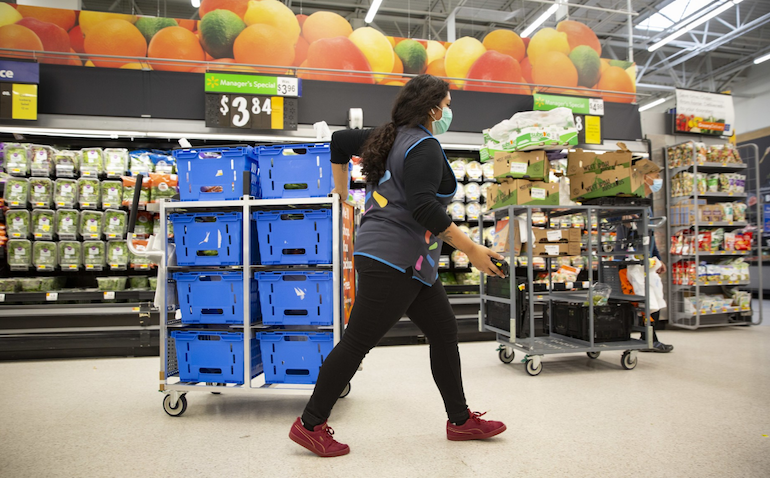Walmart beat Wall Street’s earnings forecast by 31 cents in its fiscal 2021 second quarter and posted net and comparable sales gains of more than 9% across its U.S. retail footprint.
For the quarter ended July 31, overall revenue totaled $137.74 billion, up 5.6% from $130.38 billion a year earlier, Walmart said Tuesday. In constant currency, revenue rose 7.4% to $140.17 billion.
Net sales at Walmart U.S. climbed 9.5% to $93.28 billion in the second quarter from $85.2 billion a year ago. Comparable sales were up 9.1% year over year and, excluding fuel, grew 9.3%, spurred by sales of general merchandise and food, Walmart reported. Total transactions fell 14%, but the average ticket size swelled by 27%.
“Comp sales were strong again this quarter at 9.3% excluding fuel,” Walmart President and CEO Doug McMillon told analysts in a conference call on Tuesday. “There were several tailwinds affecting our Q2 performance, including government stimulus, more people eating at home, a focus by customers on entertaining themselves at home, and investing in their homes and yards. We also had some headwinds, including reduced store hours and out-of-stocks. As the benefits from stimulus wane towards the end of the quarter, we saw comp sales settle into a more normal range.”

“Grocery sales had another strong quarter, including robust growth in fresh,” CFO Brett Biggs said.
In grocery, comparable food sales advanced in the high single digits, with strength across most categories, while nonfood consumables sales were led by household chemicals and paper goods, according to Walmart.
“Grocery sales had another strong quarter, including robust growth in fresh,” Chief Financial Officer Brett Biggs said in the call.
Health and wellness comp sales were up in the low single digits, as comparable pharmacy sales increased by a mid-single-digit percentage, mainly due to branded drug inflation and mix, the company said. GM comp sales rose by mid-teens, with a strong performance across home, electronics, outdoor living and lawn and garden, sporting goods and apparel.
Walmart U.S. e-commerce sales jumped 97% for the quarter and contributed 600 basis points to comp sales growth. Online grocery pickup and delivery services continued to experience all-time high sales volumes, Walmart noted.
“We’re pleased with the progress we’re making on Walmart.com. We had really strong sales growth and significantly reduced losses. The tailwinds we’re experiencing are accelerating our progress to build a healthier e-commerce business as we add new brands, improve product mix, grow the marketplace and achieve more fixed-cost leverage,” McMillon explained. “The stores and online merchant teams are now integrated, and we believe we’ll benefit from that change going forward.”
McMillon also addressed productivity improvements as Walmart steps up its use of automation to more efficiently fill online orders. “The improvements in contribution profit and reduced operating losses are really good to see,” he said. “We’ve made several structural changes within Walmart U.S. during the quarter as we continue on our path to transform into an omnichannel organization. These changes were made to increase innovation, speed and productivity. This is obviously a difficult time for these associates to experience changes like this, so we’re providing additional financial support and time to look for another role along with other forms of support to make that easier than it would otherwise be.”
At Sam’s Club, second-quarter sales came in at $16.38 billion, up 8.8% from $15.05 billion in the prior-year period. Comparable sales gained 8.7% overall and 13.3% without fuel. The number of transactions rose 8.7% and the average basket size by 4.3%. E-commerce sales surged 39% during the quarter and contributed 190 basis points to comp-sales growth.
The warehouse club chain saw strength across categories, led by food and nonfood consumables, according to Walmart. Fresh, frozen and refrigerated foods had comp-sales growth in the low 20s, while center-store grocery and beverage categories saw a high-teens gain, as did nonfood consumable items.
“The team delivered comps of 17.2% excluding fuel and tobacco and grew membership income 7.8%. We saw improvements in member count, renewal rates, and plus member penetration,” McMillon said of Sam’s Club. “The popularity of Scan & Go [self-checkout] is accelerating, which is great to see. The membership value proposition is strong, and the team is executing well.”

Walmart said online grocery pickup and delivery services continued to experience all-time-high sales volumes in the quarter.
Walmart’s overall U.S. comp sales, including Walmart U.S. and Sam’s Club, grew 9% for the second quarter and were up 9.9% excluding fuel.
“E-commerce sales were strong throughout the quarter, contributing approximately two-thirds of the segment comp growth. We saw significant increases in repeat rates and weekly active digital customers, and we continue to make progress on assortment expansion and seller tools with e-commerce marketplace sales growing triple digits,” Biggs said of the Walmart U.S. performance. “We’re accelerating investments in omni-fulfillment solutions, including the continued rollout of same-day pickup and delivery services to more stores, expanding store pickup and delivery slots by nearly 30% since February, and permanently increasing ship-from-store capabilities from pre-COVID levels.”
Meanwhile, second-quarter net sales at Walmart International fell 6.8% to $27.17 billion from $29.14 billion a year earlier. In constant currency, the unit’s net sales edged up 1.6% to $29.61 billion. In North America, net sales (in constant currency) rose 13.9% for Walmart Canada and 5.7% for Walmart Mexico, while comp sales were up 14% and 4.1%, respectively.
“International’s results were better than anticipated coming into the quarter,” said Biggs. “Despite operational limitations in several markets due to the [coronavirus] crisis, including the government-mandated closure of Flipkart [in India], net sales increased 1.6% in constant currency, including nearly 40% growth in e-commerce.”
At the bottom line, Walmart’s net income for the second quarter totaled $6.48 billion, or $2.27 per diluted share, compared with $3.61 billion, or $1.26 per diluted share, in the year-ago period.
Adjusted earnings per share (EPS) were $1.56, well above the top end of Wall Street’s projection. The company said adjusted EPS excludes the net-of-tax impact of an unrealized gain on equity investments (89 cents per share), a U.S. business restructuring charge (10 cents per share) and a discrete tax item (8 cents per share).
Analysts, on average, had forecast Walmart’s second-quarter adjusted EPS at $1.25, with estimates ranging from a low of $1.07 to a high of $1.39, according to Refinitiv/Thomson Reuters.
“Consistent with our first quarter release, we aren’t providing fiscal-year 2021 financial guidance due to continued uncertainty around key external variables related to the health crisis and their potential impact on the business and the global economy,” Biggs said. “The health crisis has created both tailwinds and headwinds to our business. In Q2, we saw stronger-than-expected sales, due in large part to stock-up buying and stimulus spending, but the duration of extended future government stimulus remains uncertain. In Q2, stimulus spending improved our sales mix and, in turn, gross margin and operating profit. We’ve also managed the greater operational complexities and incurred incremental costs to ensure associate and customer safety, and some of those will continue.”
Prior to Walmart’s earnings call, analysts’ full-year consensus estimate for adjusted EPS was $5.01, with projections running from $4.26 to $5.25, according to Refinitiv/Thomson Reuters.
“Despite the various challenges,” Biggs said, “our strong performance throughout the dynamic and challenging first half of the year reinforces the strength of this business and the omnichannel strategy we’re leading.”
As of July 31, Walmart had 11,496 stores under 56 banners in 27 countries and e-commerce websites in 10 countries. That includes 4,753 Walmart and 599 Sam’s Club stores in the United States and 6,143 international locations.
For our most up-to-date coverage, visit the coronavirus homepage.





